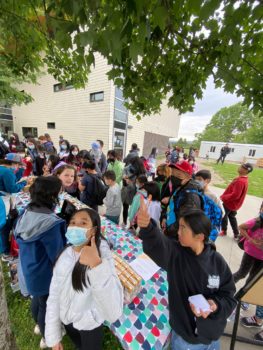Vancouver: collaboration and the junior youth programme
At a recent learning site seminar, friends shared insight into how the Vancouver cluster reached its goal of sustaining 300 participants in the junior youth spiritual empowerment programme.
A junior youth graduation ceremony in the Central Richmond neighbourhood. They have now started studying Book 1.
Last year, the Vancouver cluster passed a milestone in the growth of its junior youth spiritual empowerment programme. As a site for the dissemination of learning[i] about the programme, supporting a number of associated clusters in strengthening their programs, the cluster was tasked with taking 300 junior youth through the series of texts.[ii] As a significant step, the cluster first aimed to sustain the participation of 300 junior youth in the programme—a goal that was recently achieved.
In January 2016, the Universal House of Justice provided the learning sites with a new vista: “In recent years, the sites for learning about the junior youth programme have made impressive progress in systematizing the lessons being garnered as junior youth groups have multiplied. The body of knowledge and the strategies associated with sustaining five to ten groups with some 50 to 100 junior youth in a cluster have now been well established and documented. Looking ahead, the sites and their associated clusters will need to pay greater attention to learning to raise the number of groups to 30, engaging some 300 junior youth.”
Reaching 300 junior youth could not be undertaken by a small group of friends labouring in a few centres of intense activity, often described as neighbourhoods with more than 20 core activities, with tens of people facilitating the participation of hundreds. Greater degrees of unity and collaboration were needed on the part of cluster institutions and agencies, to avoid fragmentation between the work in centres of intense activity and across the cluster. They also gained a fresh understanding of the learning site as part of the cluster, rather than a handful of centres of intense activity operating in isolation. As the agencies and institutions, as well as their many collaborators, learned to work more closely together to advance the process of growth in the cluster, a path toward the participation of 300 junior youth began to take shape.
The learning generated in centres of intense activity—where the friends are developing capacities needed to push beyond a basic junior youth programme and sustain the participation of at least 100 or more junior youth—remained critical in this process. The Richmond, Edmonds and Commercial Drive neighbourhoods periodically gathered to exchange insights, challenges and next steps. They also reflected on guidance from the Universal House of Justice and adopted learning objectives for their individual neighbourhoods.
As this goal advanced in centres of intense activity, insights about sustaining growth began to emerge. Teams of friends began to meet and interact daily and seized opportunities to deepen relationships with local institutions and organizations, seeing themselves as working towards a common aim. As a growing number of people became engaged, numerous opportunities emerged to collaborate more closely with schools and other institutions in the community. These relationships evolved from being merely transactional, such as requesting use of community spaces, to that of allies working towards a common goal of serving the community.
The capacity of tutors to accompany others in the field of service was growing. The friends who are serving in the neighbourhoods needed to learn how to raise up new human resources enkindled with the love of Bahá’u’lláh and committed to the spiritual education of young people in their community. This was not possible without a handful of capable tutors serving in the neighbourhood who were growing in their capacity to help young people put into action the knowledge, capacities, and skills laid out in the sequence of courses. In many cases, a growing number of youth developed these capacities in the context of animating a junior youth group. Many of the tutors, who are themselves capable animators, walk side by side with the new animators to accompany them. The learning that emerged from these efforts helped each of the three centres—Richmond, Edmonds and Commercial Drive—to reach approximately 100 junior youth in the programme.
The centres then became rich reservoirs of insights and human resources to be drawn on to assist the growth of other emerging neighbourhoods in the cluster. The Richmond and Edmonds neighbourhoods began accompanying nascent teams in advancing the junior youth spiritual empowerment programme in their own localities. This included spending time in the field of service together and visiting one another’s team planning and reflection spaces. These efforts led to the growth of several emerging centres of intense activity in the cluster, including Killarney, Metrotown, and City Hall, where friends are now labouring towards a basic junior youth programme.
Besides the efforts being made in centres of intense activity, cluster agencies and institutions continued to learn about the growth of the junior youth empowerment programme across the cluster. They concluded that for the programme to grow, it had to become rooted in growing numbers of expanding nuclei: those engaged in a pattern of action that widens the circle of friends arising as protagonists in the context of core activities. In the past, junior youth groups that formed outside of the centres of intense activity were often isolated. These groups generally struggled to sustain over time or to realize the full potential of the growth process. Those accompanying the programme at the cluster level began ensuring that all groups were formed in the context of an expanding nucleus. They also identified nuclei that would be capable of quickly absorbing lessons from the centres of intense activity and began helping these nuclei to apply these lessons within the context of their own realities.
The cluster institutions and agencies, aided by Auxiliary Board members and their assistants, ensure the continued dissemination of learning across the cluster. These efforts have led the cluster to sustain the participation of 332 junior youth in 36 groups.
[i] A previous article in Bahá’í Canada described the concept of a learning site: https://bahaicanada.bahai.ca/reflection-seminars-for-the-junior-youth-programme-in-vancouver-and-toronto/
[ii] A list of current junior youth texts can be found here: https://www.ruhi.org/en/programs-and-materials/#junior-youth
Category: Features









